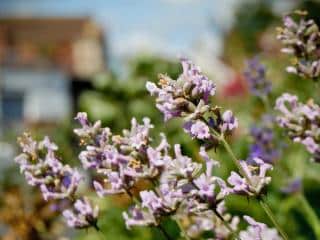Portuguese lavender is a rare, appealing type of lavender.
Portuguese lavender facts
Name – Lavandula latifolia
Family – Lamiaceae
Type – sub-shrub (herbaceous)
Exposure – full sun
Soil – ordinary, very well-drained
Height – 1 to 2+ feet (30 to 80 cm)
Foliage: evergreen – Blooming: summer, early fall (weather-dependent)
Its essential oil is distinct from that of other species. This makes it a prized fragrant plant in many gardens.
Care is rather straightforward. As long as you keep its feet dry between waterings, it will grace you with many flowers!
- Note: There is another lavender species, Lavandula stoechas, which has a cultivar named ‘Portuguese Giant’. It is different from the species presented in this page, which goes by the name Lavandula latifolia in botanical circles.
How to plant Portuguese lavender
Portuguese lavender does best in the ground, but it still is great for growing in pots.
Planting Portuguese lavender in the soil
Follow these shrub planting tips, but remember to increase drainage.
Plant your Portuguese lavender in any season.
- Spring and fall are best
- Summer and winter are possible, but only on mild days: no hot days, no freezing
Best exposure
Portuguese lavender is an excellent plant for full sun. It can take heat and hot sun without any consequence.
- Although it will still flower and bloom in the shade, it will strive and grow leggy.
- Blooming in the shade isn’t very beautiful.
Soil type
For small shrub, Portuguese lavender sends out deep roots. This is because it’s used to growing in a dry environment where water is hard to reach.
- drainage is essential
- clay soil is all right, but only if water drains well.
- Plant atop a mound if your soil stays soggy for a long time after a heavy rain.
- Best is neutral to slightly alkaline soil (chalky soil). Acidic soil will slow its growth.
- Soil can be poor. Adding nutrients will help enhance blooming though.
Portuguese lavender pruning and trimming
Shaping and trimming Portuguese lavender
However, to shape your lavender into a harmonious, round shape, best is to trim in the following manner:
 Trim after the blooming, around the end of summer.
Trim after the blooming, around the end of summer.- With long shears, snip all around the bush, cutting a sphere.
- Cut only about half as deep as the leaf-bearing portion of stems goes.
- This is called maintenance pruning for lavender. It will ensure a nice, round bearing.
If your Portuguese lavender has grown ugly or leggy, you can rejuvenate the shrub by clearing out about half of the branches.
Pruning Portuguese lavender for its flowers
Lavender essential oil producers harvest Portugal lavender for its oil.
- They harvest the flowers scapes when the plant is in full bloom.
- This is usually early on in summer.
Although they use specialized machinery for this, all you need is a pair of long shears or even simple garden scissors!
- Gather a handful of flower stems and snip them off.
- If harvesting for oil, cut the stems short, just under the flower.
- If harvesting for dried flower bouquets or to weave lavender wands, cut each stem as long as possible.
Growing Portugal lavender in pots
Best type of pots for Portugal lavender
Pots are a treat for Portuguese lavender. Since this species of lavender is rather small, it does well in pots and containers.
- Terra cotta pots are better at keeping the plant cool in summer as long as it’s well-watered. Terra cotta pots are thicker and make changes in temperature and water level more gradual.
- Plastic pots are better at keeping water in but tend to warm up on hot, sunny days. This delays water stress, but when it hits, it hits harder.
- Whatever the type of pot, make sure drainage is perfect and remember to water often.
Watering is crucial for all potted plants. However, for Portuguese lavender, make sure the soil dries up almost entirely before watering again. This will help prevent root rot.
Repotting and fertilizer
Repot the plant every two years in a slightly larger pot.
- When the plant is older than 5 or 6 years old, stop increasing the size of the pot.
- Simply prune off some of the roots when you replace the soil mix.
- If the pot is too large, or if you’re growing in a wide container or garden box, simply topdress with fresh potting mix.
For rich, intense blooming, feel free to fertilize during the blooming season (spring to early summer).


 Trim after the blooming, around the end of summer.
Trim after the blooming, around the end of summer.